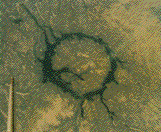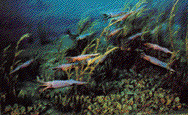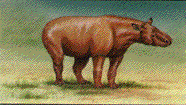Minor Extinctions of Earth History
Although mass extinctions are most studied by the paleontological community, several smaller-scale extinctions have also been documented. These extinctions, occurring in the Triassic, Jurassic, Oligocene, and Neogene, did not affect as many species as the major mass extinctions, but are critical to understanding the patterns of extinction.
The Triassic Extinction
 Labyrinthodont amphibians, conodonts, and all marine reptiles(excluding ichthyosaurs) were eliminated and mammal-like reptiles, thecodonts, brachiopods, gastropods, and molluscs were severly affected by this event. The causes of the Triassic extinction are not well known, but popular explanations for its occurrence include global climatic cooling, extra-terrestrial impact, or comet showers. This extinction event is particularly important because it allowed the dinosaurs to radiate into terrestrial niches that were previously unavailable.
Labyrinthodont amphibians, conodonts, and all marine reptiles(excluding ichthyosaurs) were eliminated and mammal-like reptiles, thecodonts, brachiopods, gastropods, and molluscs were severly affected by this event. The causes of the Triassic extinction are not well known, but popular explanations for its occurrence include global climatic cooling, extra-terrestrial impact, or comet showers. This extinction event is particularly important because it allowed the dinosaurs to radiate into terrestrial niches that were previously unavailable.
The Jurassic Extinction
 Two extinction events are speculated to have occurred in the Jurassic. The first of these events is recognized in Pleinsbachian age strat from Europe. This extinction eliminated more than eighty percent of marine bivalve species, along with various
other shallow water species. The second crisis occurred near the end of the Jurassic, by an event that severly affected ammonoids, marine reptiles, and bivalves. Dinosaurs were also severly affected as stegosaurs and most types of sauropods did not survive into the Cretaceous period. This event is not well understood so few hypothese have yet been proposed for its occurrence.
Two extinction events are speculated to have occurred in the Jurassic. The first of these events is recognized in Pleinsbachian age strat from Europe. This extinction eliminated more than eighty percent of marine bivalve species, along with various
other shallow water species. The second crisis occurred near the end of the Jurassic, by an event that severly affected ammonoids, marine reptiles, and bivalves. Dinosaurs were also severly affected as stegosaurs and most types of sauropods did not survive into the Cretaceous period. This event is not well understood so few hypothese have yet been proposed for its occurrence.
The Oligocene Extinction
 The early Oligocene extinction event was triggered by severe climatic and vegetational changes, and drastically affected land mammals. At this time, the world experienced a global cooling that shuffled many of the existing biomes. Tropical areas, such as jungles and rainforests, were replaced by more temperate savannahs and grasslands. This change in biomass forced dramatic changes in the distribution of Oligocene flora and fauna. Typically, forest dwellers declined as forested habitat became less abundant, and in their place, hoofed animals flourished due to the growing number of temperate grasslands. A number of predators also became extinct at this time, due primarily to the faunal changes. Major mammal groups that perished included mesonychids and creodonts.
The early Oligocene extinction event was triggered by severe climatic and vegetational changes, and drastically affected land mammals. At this time, the world experienced a global cooling that shuffled many of the existing biomes. Tropical areas, such as jungles and rainforests, were replaced by more temperate savannahs and grasslands. This change in biomass forced dramatic changes in the distribution of Oligocene flora and fauna. Typically, forest dwellers declined as forested habitat became less abundant, and in their place, hoofed animals flourished due to the growing number of temperate grasslands. A number of predators also became extinct at this time, due primarily to the faunal changes. Major mammal groups that perished included mesonychids and creodonts.
The Neogene Extinctions
 Six major pulses of extinction have occurred since the beginning of late Miocene time. The first occurred about nine million years ago, and the most recent occurred only about eleven thousand years ago. This last crisis was restricted exclusively to large mammals, eliminating thirty-nine genera. Among the species eliminated were saber-toothed cats, mastodons, wooly mammoths, huge ground sloths, short-faced bears, and dire wolves. Causes for this extinction are also widely debated. Hypotheses for this extinction include global climatic cooling, and human over-hunting.
Six major pulses of extinction have occurred since the beginning of late Miocene time. The first occurred about nine million years ago, and the most recent occurred only about eleven thousand years ago. This last crisis was restricted exclusively to large mammals, eliminating thirty-nine genera. Among the species eliminated were saber-toothed cats, mastodons, wooly mammoths, huge ground sloths, short-faced bears, and dire wolves. Causes for this extinction are also widely debated. Hypotheses for this extinction include global climatic cooling, and human over-hunting.
 Patterns of Extinction
Patterns of Extinction
 Mass Extinctions of the Phanerozoic Menu
Mass Extinctions of the Phanerozoic Menu
 Main Menu
Main Menu
 The early Oligocene extinction event was triggered by severe climatic and vegetational changes, and drastically affected land mammals. At this time, the world experienced a global cooling that shuffled many of the existing biomes. Tropical areas, such as jungles and rainforests, were replaced by more temperate savannahs and grasslands. This change in biomass forced dramatic changes in the distribution of Oligocene flora and fauna. Typically, forest dwellers declined as forested habitat became less abundant, and in their place, hoofed animals flourished due to the growing number of temperate grasslands. A number of predators also became extinct at this time, due primarily to the faunal changes. Major mammal groups that perished included mesonychids and creodonts.
The early Oligocene extinction event was triggered by severe climatic and vegetational changes, and drastically affected land mammals. At this time, the world experienced a global cooling that shuffled many of the existing biomes. Tropical areas, such as jungles and rainforests, were replaced by more temperate savannahs and grasslands. This change in biomass forced dramatic changes in the distribution of Oligocene flora and fauna. Typically, forest dwellers declined as forested habitat became less abundant, and in their place, hoofed animals flourished due to the growing number of temperate grasslands. A number of predators also became extinct at this time, due primarily to the faunal changes. Major mammal groups that perished included mesonychids and creodonts.